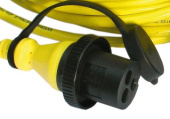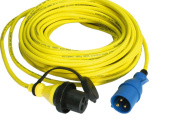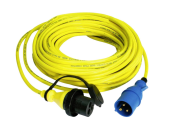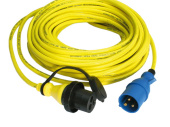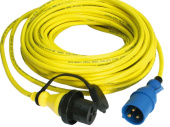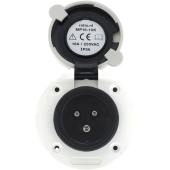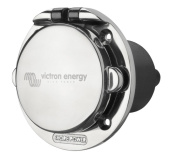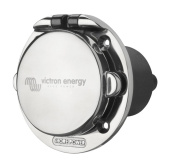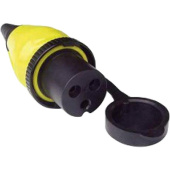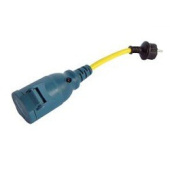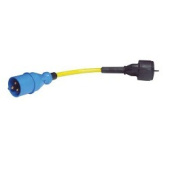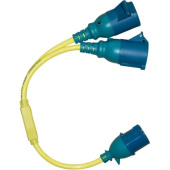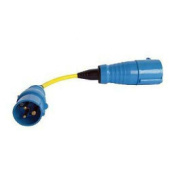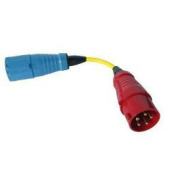A marine shore power cord is a vital component for providing electrical power to boats and yachts while docked. These cords connect the vessel to shore-based power sources, enabling the use of onboard electrical systems and appliances without relying on the boat’s batteries. Typically, marine shore power cords are constructed from durable, weather-resistant materials to withstand the harsh marine environment, including exposure to saltwater, UV rays, and temperature fluctuations.
|
1-2 weeks delivery time Victron Energy stainless steel shore power inlets offer robust IP56-rated waterproof protection and reliable IEC 60309 2p+E connectivity. Available in 16A and 32A versions, these inlets feature a solid cast 316 stainless steel cover, nickel-plated brass pins, and are CE certified for marine and mobile power applications. Ideal for securely connecting shore power to your vessel or RV in demanding environments.
|
$ 137,27
Current (Amps):
| |||
|
1-2 weeks delivery time Victron Energy Shore Power Cords are robust, IP56-rated marine-grade cables for safe shore-to-boat AC connections. Available in 16A, 25A, and 32A ratings with 15m or 25m lengths, they feature moulded IEC 60309 connectors, yellow H07BQ-F heavy-duty cable, LED power indicators, and protection caps on female ends. CE certified for safe use in wet environments with solid mechanical performance.
|
$ 243,29
Current (Amps):
Length, m:
| |||
|
1-2 weeks delivery time Victron Energy Shore Power Plugs are heavy-duty IEC 60309-compliant connectors rated for 250VAC in 16A and 32A configurations. Designed to mate perfectly with Victron stainless steel shore power inlets, these 2-pole + earth (2p+E) plugs feature a rugged PA6 polyamide body and nickel-plated brass pins for superior corrosion resistance in marine and RV environments. CE certified and waterproof to IP56.
|
$ 108,73
Current (Amps):
| |||
|
1-2 weeks delivery time The Victron SHP302501500 is a heavy-duty 15-meter shore power cable rated at 16A and 250V AC. Built with high-quality H07BQ-F 3x2.5mm² cable, it features molded IEC 60309 blue plug and black/yellow connector with a power indicator LED and waterproof IP56 protection. Designed for marine and outdoor applications, the cable includes a female connector with a protective cap and is CE certified for reliable operation in wet and demanding environments.
|
$ 243,29
-
+
| |||
|
1-2 weeks delivery time The Victron SHP302502500 is a 25-meter waterproof shore power cable designed for marine and RV applications. Rated at 16A and 250V AC, it uses high-grade H07BQ-F 3x2.5mm² yellow cable with molded IEC 60309 blue plug and a black/yellow connector featuring an integrated LED power indicator and protective cap. Certified to IP56 and CE standards, this cable ensures safe and reliable shore power connectivity in outdoor environments.
|
$ 328,92
-
+
| |||
|
1-2 weeks delivery time The Victron Energy SHP304001500 shore power cable is a robust 15-meter connection solution designed for marine and industrial applications. Rated at 25A and 250V AC, this CE-certified cord features a durable H07BQ-F 3x4.00mm² yellow cable with moulded IEC 60309 3-pole plug and connector. A built-in power LED indicator and protective cap on the female connector enhance usability and safety, while the IP56 waterproof rating ensures reliable performance in harsh outdoor conditions.
|
$ 312,61
-
+
| |||
|
1-2 weeks delivery time The Victron Energy SHP306002500 is a heavy-duty 25-meter shore power cable designed for high-current marine and industrial connections. It supports up to 32A at 250V AC through a waterproof IP56-rated housing. The cable features moulded IEC 60309 3-pole plug and connector, a high-durability H07BQ-F 3x6.00mm² yellow cable, and includes an LED power indicator and protective cap on the female connector. Certified to CE standards, this robust cord is ideal for demanding shore power installations.
|
$ 608,92
-
+
| |||
|
1-2 weeks delivery time The Victron Energy SHP301603000 is a waterproof shore power inlet rated at 16A and 250V AC, designed for marine and mobile applications. Built with a durable glass-filled PA6 polyamide housing and nickel-plated brass pins, it complies with IEC 60309 (2P+E) standards and offers reliable performance in harsh environments. Featuring an IP56 ingress protection rating and CE certification, this 3-pole inlet is a lightweight and corrosion-resistant alternative to stainless steel models, weighing just 0.23 kg.
|
$ 95,14
-
+
| |||
|
1-2 weeks delivery time The Victron Energy SHP301602000 is a rugged shore power inlet rated at 16A and 250V AC, designed for marine-grade durability and high corrosion resistance. Featuring a solid cast 316 stainless steel cover, nickel-plated brass pins, and a waterproof IP56 rating, this CE-certified IEC 60309-compliant inlet ensures safe and secure shore power connectivity in harsh outdoor environments. It weighs 0.34 kg and is compatible with standard 2P+E IEC plugs.
|
$ 137,27
-
+
| |||
|
1-2 weeks delivery time The Victron Energy SHP303202000 is a high-capacity shore power inlet rated for 32A and 250V AC, ideal for demanding marine and outdoor applications. Designed with a solid cast 316 stainless steel cover and a rugged PA6 polyamide body, it provides superior corrosion resistance and mechanical strength. Featuring nickel-plated brass pins and IP56 ingress protection, this CE-certified inlet complies with IEC 60309 (2P+E) standards and ensures secure, weatherproof power connectivity.
|
$ 178,05
-
+
| |||
|
1-2 weeks delivery time The Victron Energy SHP301604000 is a 16A, 250V AC male plug designed for secure and waterproof connection to compatible shore power inlets. Compliant with IEC 60309 (2P+E) standards, it is intended for use with 3-wire systems and features a robust construction for marine and outdoor applications. This plug is CE-certified and ideal for coupling with Victron 16A power inlets such as the SHP301602000 and SHP301603000.
|
$ 108,73
-
+
| |||
|
1-2 weeks delivery time The Victron Energy SHP303204000 is a high-current male shore power plug rated at 32A and 250V AC, conforming to IEC 60309 (2P+E) standards. It is designed to connect securely with Victron 32A shore power inlets such as SHP303202000, offering waterproof, safe, and robust performance in marine and industrial environments. With a durable build and CE certification, it is ideal for heavy-duty electrical installations.
|
$ 146,80
-
+
| |||
|
1-2 weeks delivery time The Victron Energy SHP307700220 is a 16A/250V AC adapter cord designed to convert a standard Schuko plug to a CEE 16A (2P+E) connector. Ideal for marine, RV, or camping setups, this CE-certified adapter allows seamless integration of European shore power sources with equipment using CEE input plugs. Compact and easy to handle, it provides a reliable and safe temporary power interface.
|
$ 33,98
-
+
| |||
|
1-2 weeks delivery time The Victron Energy SHP307700260 is a CE-certified 16A adapter cord that converts a CEE 2P+E (male) plug to a Schuko (female) socket, allowing seamless connection of standard European appliances to industrial power sources. Rated for 250V AC, this compact and durable adapter is ideal for marine, camping, or mobile workshop applications where flexible compatibility between power standards is essential.
|
$ 32,62
-
+
| |||
|
1-2 weeks delivery time The Victron Energy SHP307700240 is a CE-certified splitter cord that enables one 16A CEE 2P+E (male) plug to power two CEE 2P+E (female) outputs simultaneously. Rated for 250V AC, this splitter is ideal for marine, RV, or workshop applications requiring multiple shore power outputs from a single source. Its rugged design ensures safe current distribution in portable setups.
|
$ 110,09
-
+
| |||
|
1-2 weeks delivery time The Victron Energy SHP307700280 is a rugged IP56-rated shore power adapter cord designed for converting a 16A CEE plug to a 32A CEE socket at 250V. Ideal for marine, RV, and industrial applications, it features a moulded IEC 60309 plug and connector (2P+E), integrated LED power indicator, and a protective cap on the female connector. Built with heavy-duty materials including a H07BQ-F flexible cable and impact-resistant molded ends, this adapter ensures a safe and durable connection in demanding environments.
|
$ 47,57
-
+
| |||
|
1-2 weeks delivery time The Victron Energy SHP307700300 is a professional-grade adapter cord designed to convert a 32A 400V three-phase CEE plug to a 32A 230V single-phase CEE socket. Perfect for scenarios where single-phase equipment must connect to a 3-phase shore power source, this adapter features a waterproof (IP56) molded construction, nickel-plated brass pins, integrated LED power indicator, and protective cap. It ensures safe and reliable power distribution in marine, mobile, and industrial environments.
|
$ 66,60
-
+
| |||
What are the main benefits of using a 30 amp marine shore power cord compared to a 50 amp option for a boat?
The main benefits of using a 30 amp marine shore power cord compared to a 50 amp option for a boat include its lighter weight and increased flexibility, making it easier to handle and store. A 30 amp cord is ideal for smaller boats or when less power is required, as it provides sufficient power (30a 125v) for most standard marine applications without the need for heavier 50 amp equipment. Additionally, 30 amp shore power cords are compatible with a wide range of adapters, such as the l5-30 marine connector, allowing seamless integration with various shore power inlets and systems. This makes them versatile for use with RVs and boats needing 125v power, especially when paired with the right shore power inlet and extension cord.
In addition to their flexibility, 30 amp marine shore power cords can be combined with various accessories, ensuring compatibility with different systems. With options like shore power cordsets and RV cords 125v 30 amp, boaters can customize their power needs effectively. Durable cords often come with shore power cable clips for secure management and 10-gauge wiring for safe power transmission.
How does a shore power cable ensure safe and reliable power transmission on a boat or RV?
A shore power cable ensures safe and reliable power transmission on a boat or RV by using high-quality materials and secure connectors designed to withstand harsh marine environments. The 30 amp 125v and 50 amp marine shore power cords typically feature a durable construction with a 10-gauge cable, providing optimal conductivity and minimizing power loss over long distances. The use of male plugs and female connectors, such as the l5-30p and l5-30r configurations, along with secure locking mechanisms like the locking ring and collar, ensures tight and weather-resistant connections, preventing accidental disconnections and protecting against electrical hazards.
What is the purpose of using a splitter with locking ring and collar in a shore power setup?
The purpose of using a splitter with locking ring and collar in a shore power setup is to safely and efficiently distribute electrical power from a single source to multiple devices on a marine vessel or RV. The locking ring and collar ensure a secure and tight connection between the marine boat shore power cord and the splitter, preventing accidental disconnections and ensuring continuous power flow. This setup is especially useful when using 30a 125v marine shore power cords or 50a systems, as it allows the power to be split into different circuits, each with specific amperage needs, while maintaining a robust connection through NEMA-standard plugs and connectors.
What types of Marine Electrical items do you have in your catalog?
Marine Generator, Boat Generator, Marine Battery Charger, Boat Battery Charger, Marine Battery, Lithium Marine Batteries, AGM Marine Battery, Marine Gel Batteries, Boat Battery, Lithium Boat Batteries, AGM Boat Battery, Gel Batteries for Boats, Marine Battery Box, Boat Battery Box, Boat Battery Switch, Marine Battery Cable, Boat Battery Cable, Marine Battery Monitor, Boat Battery Monitor, Boat Inverter, , Marine Inverter, Boat Inverter Charger, Marine Inverter Charger, Marine Shore Power Cord Boat Shore Power, Shore Power


